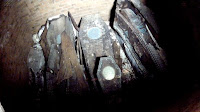 |
| Bones under the ledger stone |
The unexpected discovery
of an 8ft deep family burial vault in the North Transept of Gloucester Cathedral
is a fascinating story for me.
 Many of us have trodden
over the ledger stones at Gloucester and elsewhere and wondered what is
beneath. As a child, I hoped that there
was nothing underneath and that the actual burial was elsewhere –
perhaps a way of persuading my 12 year old self that ‘morning chapel’ wasn’t
taking place surrounded by dead bodies!
Many of us have trodden
over the ledger stones at Gloucester and elsewhere and wondered what is
beneath. As a child, I hoped that there
was nothing underneath and that the actual burial was elsewhere –
perhaps a way of persuading my 12 year old self that ‘morning chapel’ wasn’t
taking place surrounded by dead bodies!
Now, of course, I love
the idea of an intricate network of tunnels and rooms under the floor – most yet to be discovered.
Also
Benjamin Hyett & Elizabeth w…
daughter of Joseph Morwent
He dyed 1711 aged 62
She dyed 1708 aged 55
also their children
.. 1692 ..
.. 1706 ..
.. 1712 ..
And from on of the coffin lids:
Frances Hyett
Daughter of
…ny Hyett and Fran Hyett
Died Feby 16 1748?
Aged 9 Months
 |
| Inside the vault |
A very brief scan of the
internet shows a Charles Hyett (1677 or 1686 to 1738) who had two sons - Benjamin Hyett II (1708 to 1762)
and Nicholas Hyett (1709 to 1777).
Charles’s father is recorded as Benjamin Hyett (1651 to 1711) who I
think is our man – so at least one of Benjamin and Elizabeth’s children
survived.
Charles was MP for
Gloucester between 1722 and 1727 and built Painswick House “to escape the smog
of Gloucester” but he died not long after moving there.
 |
| Robins' painting |
Benjamin II inherited
Painswick House where he created the now famous Painswick Rococo Garden which
was painted by Thomas Robins the Elder in 1748.
Nicholas was a lawyer
and Justice of the Peace and one of “the last keepers and constables of the
Castle of Gloucester”.
Both Nicholas and
Benjamin II failed in their attempts to follow their father’s footsteps into
Parliament, but a long line of later descendants were more successful in this
endeavour.
Press reports show Richard
Clavering Hyett Dickinson (Lord Dickinson) as the living relative – and the
grandson of Willoughby Hyett Dickinson, 1st Baron Dickinson of
Painswick, who, like his ancestor Charles (and probably many other Hyetts) was an MP.
 |
| Painswick House |
Back to the story, I
think that I heard in a radio interview the new bishop of Gloucester – the Rt Rev Rachel Treweek- talking about
renovations to the Bishop’s Palace and the installation of a new kitchen.
Clearly her ‘new broom’ extends to the North Transept renovations and the
installation of a lift – which is how this great discovery was made.
It is only by remaining
current and fit for purpose in our ever-changing world that our great buildings
will survive – and to survive, they need to do what they have always done –
change!
My final hope is that
the plan is to record the vault by camera and then close it up and leave the
Hyetts just as they are.
Call me to discuss your
insurance needs on 0208 2550617 / 07768 865983







